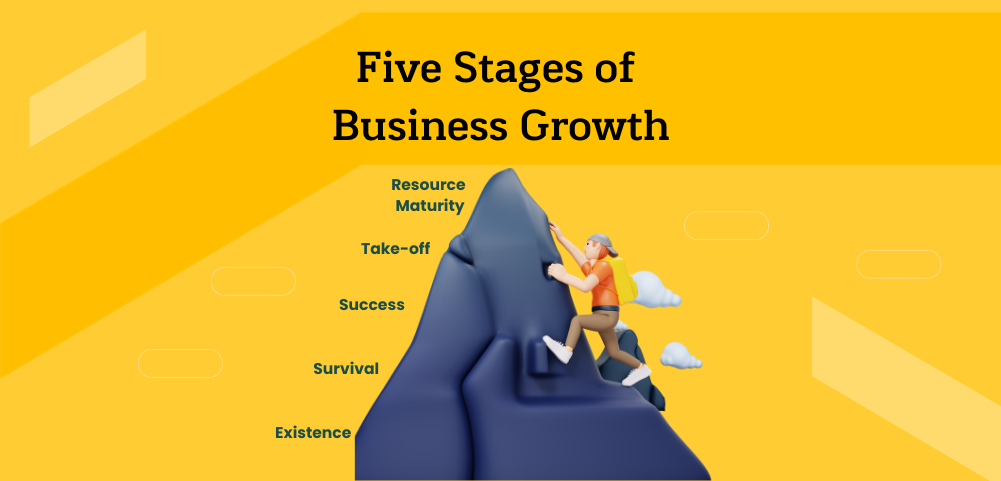The Five Stages of Business Growth Explained
by Arthur Yang November 9, 2023

Do you have an existing side hustle that you are looking to expand?
If so, “The Five Stages of Business Growth” model would help you understand the business life cycle better.
This model has been covered by reputable business journals like Harvard Business Review and Forbes.
Here’s a glimpse of what we’ll explore:
1. Stage One—Existence
2. Stage Two—Survival
4. Stage Three—Success
3. Stage Four—Take-off
5. Stage Five—Resource Maturity
6. How can you develop your side hustle into a business?
7. Conclusion
Here is Hustle’s take on the Five Stages of Business Growth model.
Five Stages of Business Growth
Five Stages of Business Growth
Five Stages of Business Growth
Five Stages of Business Growth
Stage One—Existence

Survival is the key focus, with businesses striving to generate revenue to cover basic operational costs.
Owners are deeply involved, wearing multiple hats and managing various aspects of the business to ensure its sustenance.
Processes tend to be informal, allowing for flexibility but potentially leading to challenges in consistency and efficiency.
At this stage, businesses also concentrate on building awareness, employing intensive marketing efforts to reach potential customers and establish their brand presence.
However, the existence stage is fraught with uncertainty and risk.
Many startups fail to navigate this phase due to fierce market competition, lack of funding, or an inability to meet customer demands.
Entrepreneurs must exhibit resilience and adaptability, and be willing to pivot strategies based on market feedback.
The existence stage serves as a foundation, laying the groundwork for future growth.
Successfully navigating this period requires a clear vision, determination, and a profound understanding of market dynamics and customer needs.
Businesses that manage to overcome the challenges of this stage increase their chances of progressing to subsequent phases of growth, where they can further refine their strategies, expand their customer base, and solidify their position in the market.
Stage Two—Survival

The survival stage in the life of a business is a critical period marked by the transition from mere existence to financial stability and sustainability.
As an aspiring entrepreneur, understanding this phase is crucial for your long-term success.
Firstly, during the survival stage, your primary goal is to achieve profitability.
Your business should be generating enough revenue not only to cover operational costs but also to yield a consistent profit.
This requires careful financial management, including controlling expenses, optimising processes, and ensuring a steady cash flow.
It is vital to monitor your finances closely, avoiding unnecessary expenditures, and being prudent with investments.
Customer satisfaction becomes paramount during the survival stage.
Happy customers are more likely to return and refer others, contributing significantly to your revenue stream.
Providing excellent customer service and maintaining the quality of your products or services are key aspects of building customer loyalty.
Additionally, this stage demands adaptability.
Market conditions can change rapidly, and you need to be agile in responding to these shifts.
Keep an eye on industry trends, customer preferences, and emerging technologies that could impact your business.
Being flexible and open to adjusting your strategies is essential for staying relevant and competitive.
Furthermore, the survival stage often requires strategic decision-making about business expansion.
While growth is essential, it should be well-planned and sustainable.
Assess potential opportunities carefully, considering the risks and benefits before making any significant investments or expansions.
Lastly, networking and building relationships within your industry are invaluable.
Collaborate with other entrepreneurs, attend industry events, and engage with your community.
These connections can provide support, mentorship, and potential partnerships that might be instrumental in navigating challenges and seizing opportunities.
In summary, during the survival stage, focus on achieving profitability, ensuring customer satisfaction, staying adaptable to market changes, making strategic growth decisions, and building a strong network.
By mastering these aspects, you’ll be better equipped to guide your business toward long-term success and sustainability.
Stage Three—Success
The success stage is a gratifying phase for entrepreneurs, representing a period of stability, growth, and recognition in the market.
Firstly, at this stage, your business has achieved profitability and a strong market position.
You have a loyal customer base, and your revenue is steady.
Your focus should shift towards optimising operations and enhancing customer experience.
Investing in refining your products or services can ensure they continue to meet or exceed customer expectations.
Quality and consistency are key to retaining your customer loyalty.
Consider diversifying your product or service offerings to cater to a broader market or exploring new geographic locations.
Research and development should be a continuous effort to innovate and stay ahead of competitors.
Moreover, invest in marketing and branding to reinforce your presence and attract new customers.
A well-defined brand identity can create a lasting impression and set you apart in the market.
Financial management remains vital during the success stage.
Monitor your cash flow, profits, and expenses diligently.
Efficient financial management provides the necessary resources for further growth and acts as a cushion during economic uncertainties.
Consider reinvesting profits back into the business for expansion, technology upgrades, or talent acquisition.
Additionally, fostering a positive company culture and investing in your team are critical.
A motivated and skilled workforce can drive innovation and customer satisfaction.
Encourage employee development, recognise achievements, and create a supportive work environment.
Happy employees contribute significantly to your business’s success and reputation.
Lastly, maintain a focus on customer relationships.
Engage with your customers, gather feedback, and adapt your offerings based on their evolving needs.
Customer feedback is invaluable for product improvement and maintaining a competitive edge.
In summary, during the success stage, concentrate on optimising operations, innovating your products or services, strategic planning, efficient financial management, nurturing a positive company culture, and maintaining strong customer relationships.
By embracing these elements, you can ensure the continued growth and sustainability of your business in the long run.
Stage Four—Take-off
The take-off stage represents a period of rapid growth and expansion for a business, making it a pivotal phase for aspiring entrepreneurs aiming to scale their ventures.
It is characterised by a substantial increase in sales and profits.
Your business experiences a surge in demand, often due to successful marketing strategies, innovative products, or entering new markets.
This growth phase demands careful planning and execution.
You’ll need to invest in scaling your operations, including production, distribution, and customer service.
Efficient supply chain management becomes crucial to meet the heightened demand without compromising quality.
During take-off, financing plays a significant role.
You might require additional capital to fund the increased production, marketing campaigns, or even expanding your team.
Consider various funding options such as loans, venture capital, or partnerships to secure the necessary resources for your business’s growth initiatives.
Financial planning becomes more complex, requiring accurate forecasting and budgeting to ensure sustainable expansion.
Strategic decision-making becomes even more critical in the take-off stage.
Assess market trends and consumer behaviour to make informed choices about product diversification, geographical expansion, or potential mergers and acquisitions.
It’s essential to balance ambition with practicality, ensuring that your growth plans align with your core business values and capabilities.
Moreover, technology adoption becomes integral to streamlining processes and enhancing efficiency.
Implementing advanced software solutions, automation, and data analytics can optimise various aspects of your business operations, enabling you to handle the increased workload more effectively.
Additionally, nurturing your workforce is essential during the take-off stage. Hire skilled professionals and provide them with adequate training.
A competent team is fundamental to sustaining the momentum of growth and maintaining the quality of your products or services.
Lastly, keep a keen eye on market competition. As your business grows, so does the competition.
Stay innovative, continuously improve your offerings, and focus on customer satisfaction to retain your market share.
In summary, during the take-off stage, focus on scaling operations, securing adequate financing, making strategic decisions, adopting technology, nurturing your workforce, and staying competitive.
By managing these aspects effectively, you can navigate the challenges of rapid growth and establish a strong foundation for your business’s future success.
Stage Five—Resource Maturity
The resource maturity stage represents a period of stability and optimisation for a business, marking a level of maturity in its operations and resources.
During the resource maturity stage, your business has established a strong market presence and a loyal customer base.
You should have stable revenue streams and consistent profits.
At this point, the focus shifts from rapid expansion to optimising existing resources.
This involves fine-tuning your operations, improving efficiency, and maximising productivity.
Implementing advanced technologies and automation tools can help streamline processes, reduce costs, and enhance overall performance.
Strategic diversification becomes a key consideration in the resource maturity stage.
Explore opportunities to expand your product or service offerings, enter new markets, or diversify your revenue streams.
Diversification can mitigate risks associated with market fluctuations and ensure a more stable income for your business.
Conduct thorough market research and assess the feasibility of new ventures before making strategic decisions.
Additionally, building strategic partnerships and collaborations becomes essential in this stage.
Partnering with complementary businesses or forming alliances within your industry can open up new avenues for growth, enhance your offerings, and increase your market reach.
Collaborations can also provide access to valuable resources, expertise, and customer bases.
Customer relationship management continues to be a priority during the resource maturity stage.
Focus on maintaining excellent customer service, gathering feedback, and adapting your products or services to changing customer needs.
Satisfied customers are more likely to remain loyal and recommend your business to others, contributing to long-term sustainability.
Financial management remains critical, albeit in a different context.
Allocate resources wisely, invest in research and development, and plan for the future.
Consider reinvesting profits into innovation, employee training, or expanding your market presence strategically.
Lastly, in the resource maturity stage, your role as a leader evolves.
Delegate responsibilities effectively, empower your team, and foster a positive organisational culture.
Your leadership skills are crucial for maintaining employee morale, encouraging innovation, and ensuring the continued success of your business.
In summary, during the resource maturity stage, focus on optimising operations, strategic diversification, building partnerships, maintaining excellent customer relationships, prudent financial management, and effective leadership.
By embracing these aspects, you can sustain your business’s success and position it for long-term growth and stability.
Developing your Side Hustle into a Business

Transforming your side hustle into a full-fledged business with limited capital involves strategic steps tailored to the industry.
Let’s use an example of a homegrown bakery.
Begin by optimising your baking processes, ensuring efficient use of ingredients and time.
Utilise free or low-cost digital tools for inventory management and online presence.
Prioritise exceptional customer service, establishing a personal connection through social media to showcase your delicious creations.
Leverage your local network and consider collaborations with nearby businesses for mutually beneficial exposure.
Diversify your product offerings by exploring new recipes or catering to specific dietary needs, enhancing your appeal to a broader customer base.
Incorporate customer feedback to refine your baked goods, building a loyal following.
Reinvest profits thoughtfully, allocating funds for essential equipment upgrades or marketing initiatives.
Consider involving family members or friends who share your passion for baking to contribute time and skills.
With creativity, determination, and a focus on customer satisfaction, your homegrown bakery can flourish into a successful business, even on a tight budget.
Conclusions
90% of startups fail.
Let us help you increase your chances.
If you intend to launch a business, do check out our course on Effective Social Media Marketing.
You can also contact us via the chatbot or simply drop us a DM on our Instagram page if you’d like.
. . . . .
